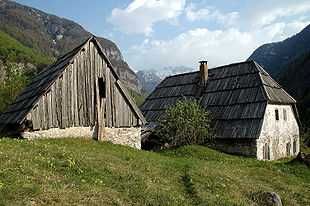Farmhouse


A farmhouse is the main house of a farm. It is a type of building or house which serves a residential purpose in a rural or agricultural setting. Historically common were farmhouses which were combined with space for animals called a housebarn. Other farm houses may be connected to one or more barns, built to form a courtyard, or each farm building was built separately.
Europe
France
- Mas (Provençal farmhouse), a traditional farmhouse in the Provence region.
Germany

Historically there were three main types of German farmhouse, many of which still survive today. The Low German house or Niedersachsenhaus (Lower Saxony house) is found mainly on the North German Plain, but also in large parts of the Netherlands. It is a large structure with a sweeping roof supported by two to four rows of internal posts. The large barn door at the gable end opens into a large hall or Deele, with cattle stalls and barns to either side and living accommodation at the end. The Middle German house may also be a single unit, but access is from the side, and the roof is supported by the outside walls. Later this type of mitteldeutsches Haus was expanded to two or more buildings around a rectangular farmyard, often with a second story. The South German house is found in southern Germany and has two main variants: the Swabian or Black Forest house and the Bavarian farmstead.[1]
Italy
Italian farmhouses include the Cascina a corte, a courtyard building whose arrangement is based on the Roman villa found in the Po Valley of northern Italy.
Norway
Norwegian farmhouses used timber or logs and built using Scandinavian vernacular architecture. The first examples are traced back to the 13th century. In some cases farmhouses are built on steep hillsides of the fjords such as the Me-Åkernes farm.
Spain
- Alqueria, a farm complex named from the historical, Muslim region Al-Andalus. This term also means a type of small village.
- Masia in the Catalan Countries
- Baserri found in the Basque Country in Northern Spain and Southwestern France.
- Haciendas sometimes involved farming.
- Palloza, a primitive dwelling.


North America
Canada
Canadian farmhouses were influenced by European settlers. In Quebec, the style varied from Gothic to Swiss, with the kitchen being the most important room in the house. In Ontario, the farmhouses of the late 19th century were of Victorian influence. Earlier ones used clapboard and later variations had brick. Many had front porches. In the west, dwellings varied from single story wooden homesteads to straw huts. Wooden houses were built later as railroads brought wood from the Rockies (Alberta, British Columbia). By 1915 houses could be purchased as kits from Eaton's catalog. Canadian homes often differ from their American counterparts in that the porch was often enclosed.
From 1850 onward many featured vernacular interpretations of the more formal architectural styles, such as Greek Revival, Italianate, Carpenter Gothic, and Queen Anne.
See also
- Barn
- Cascina a corte
- Homestead (buildings)
- Masía
- Home portal
References
- ↑ Dickinson, Robert E. (1964). Germany: A regional and economic geography (2nd ed.). London: Methuen. pp. 152–154. ASIN B000IOFSEQ.
If your doing farmhouse im here to tell you. DONT!!!!! your welcome
External links
| Wikimedia Commons has media related to Farmhouses. |
- Traditional French-Canadian ( Quebec ) Architecture
- Canadian Heritage Gallery
- The Homestead House
- Farmhouses of Hälsingland, Sweden
| |||||||||||||||||||||||||||||||||||||||||||||||||||||
